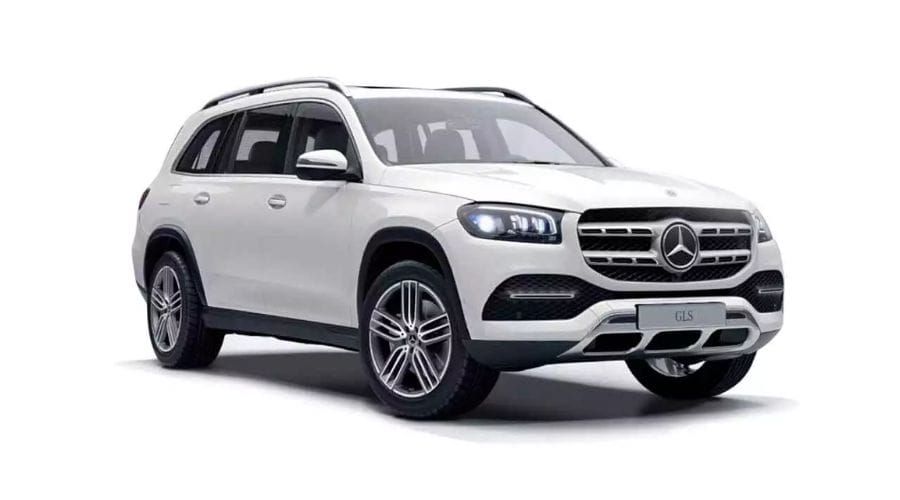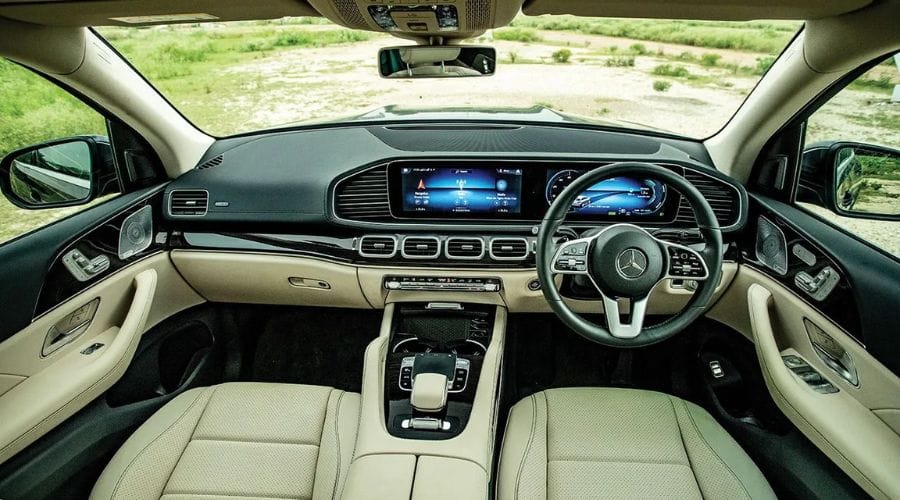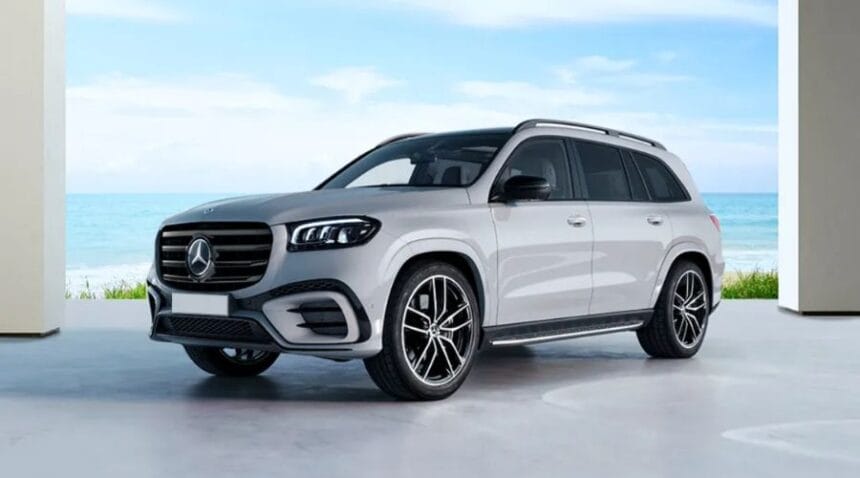Mercedes-Benz GLS models of this generation have proven to be popular due to their large size and commanding presence on the road, as well as their luxurious interiors and capacity to comfortably seat up to seven people. The mid-life redesign of the GLS aims to suit the demands of discriminating clients while updating its appeal. This upgrade includes improved petrol and diesel engines, cosmetic improvements, and an extended feature list.
Exterior Of Mercedes-Benz GLS
When it comes to drawing attention, particularly positive attention, nothing compares to the GLS. The grille’s enormous, conspicuous three-pointed star is the first thing to catch the eye. That establishes the overall aesthetic of the redesigned GLS, which also gains from minor sheet metal adjustments. The front bumper has been redesigned, the headlamps and taillamps are LED, and the horizontal, slatted grille is completed in silver. Its façade has seen very little modification, but that is okay because it is still elegantly styled. Other drivers will appreciate and admire it for its imposing presence and appearance of regality.
Features and interior of the Mercedes-Benz GLS

Its interior has undergone subtle style adjustments that further inject some freshness. Although the inside color options for the GLS are beige, black, or all black, our test car was outfitted in a brown and black design. It also has air vents in the Maybach style. The dashboard, doors, and central console’s lacquered wood trims have been replaced with classy gloss black panels with silver pinstripes. The other notable modification is a new steering wheel that combines physically operated and touch-activated controls, making it very convenient to use while driving.
The GLS retains its dual-screen design, but the infotainment system has been updated with the newest software to improve touch sensitivity and provide wireless Apple CarPlay and Android Auto. Along with additional off-road screens, it also receives a unique invisible bonnet feature that uses front and side cameras to stitch together an image of what’s underneath the car to help the driver in dangerous terrain. The front chairs now include seat ventilation and heating, which further enhances comfort. The plus-sized seats are still as cozy and accommodating as they were previously.
You will need to step up on the fixed footboard to enter the GLS. The first thing you’ll notice about the middle row is how much room there is, with enough room to accommodate the passengers in the back. In addition to the middle row bench’s electronic recline and slide, the front passenger seat can now be moved forward by pressing a button, giving you the most space to stretch out. This is a new boss feature. However, because the huge AC console takes up their knee area, a middle passenger won’t feel welcome, and the bench seat can only accommodate two adults. This raises the question of why Mercedes, which sells the captain chair option in foreign markets, did not offer one for the middle row like the BMW X7.
Soft headrest cushions, twin rear entertainment screens, and a tablet to operate both the infotainment screen and these screens—which is stored in the armrest console—come standard with this facelifted rear seat kit. Although the rear seats’ high-definition screens are expected to keep the passengers amused during a lengthy drive, their positioning on the front seatback makes them feel a little obtrusive and reduces the available space.
The middle row seats are electrically operated, and they fold and slide forward slowly, making it easy, though slow, to get into the third row. Even for large adults, there is ample head and footroom, but not much knee room. Nonetheless, even adults can comfortably sit here for lengthy journeys with a little modification to the center row. Large windows and a fifth-zone climate control option for each air conditioner in the last row guarantee that people don’t feel cramped in. Even with all rows in place, the boot’s 355 liters of cargo capacity is enough. You can nearly completely fold the center and rear seats flat for more flexibility, which will release an incredible 1,470 liters of cargo space.
Performance of the Mercedes-Benz GLS
The 3.0-liter 6-cylinder (two-scroll) turbo-petrol in the “450” version of the gasoline GLS is carried over, however, it gains a little power boost to 381 horsepower (as opposed to 367 horsepower of the previous car). The 500Nm torque output does not change. Immediately upon launch, it exudes strength and responsiveness, effortlessly towing this nearly 2.5-ton SUV. Additionally, this motor seems quite eager to spin and, at higher revs, produces a very endearing, raspy noise. A new mild-hybrid system that complements the engine produces an extra 20 horsepower and 200 Nm of torque when the vehicle is under severe load.
Although the engine’s healthier 250Nm thrust was theoretically provided by the older mild-hybrid system, actual performance data tells a different story. The GLS 450 petrol achieved a 100 kph standstill in 6.23 seconds during our tests, almost a full second faster than the outgoing model. The rolling acceleration durations from 20 to 80 kph and 40 to 100 kph also show a similar pattern. Power is effectively transferred to the wheels by the 9-speed automatic transmission without any needless jerks or hesitation.
| New GLS 450 | Old GLS 450 | |
| 0-20 Kph | 0.83s | 0.93s |
| 0-40 Kph | 1.72s | 1.96s |
| 0-60 Kph | 2.99s | 3.27s |
| 0-80 Kph | 4.34s | 4.90s |
| 0-100 Kph | 6.23s | 7.15s |
| 0-120 Kph | 8.47s | 9.76s |
| 0-140 Kph | 11.20s | 13.35s |
| 20-80 Kph (in kick down) | 3.76s | 4.35s |
| 40-100 Kph (in kick down) | 4.78s | 5.33s |
The environment inside the cabin is relatively quiet, and the GLS effectively blocks out background noise and traffic noise because it has laminated glass that has an acoustic coating on it in addition to all the other sound-deadening features.
The GLS is suspended by air, the same as before, with a distinct emphasis on comfort. Despite the 21-inch wheels, it absorbs smaller potholes and protects passengers from shocks to the road quite effectively. The ride is not as smooth as we would have liked, though, with a good deal of suspension movement; at highway speeds, it feels floaty and willowy. For highway driving, we would have preferred a Sport mode that would have reduced body motions by stiffening the suspension rather than boosting engine output. Regretfully, the available modes are limited to Comfort and Eco.
Its mild handling makes driving it incredibly effortless. Numerous autonomous driver assistance systems (ADAS), including adaptive cruise control, lane-keeping assistance, blind spot assistance, and autonomous emergency braking (AEB), are also included in the GLS. But like many other Mercedes current automobiles, the AEB is simply too sensitive for our clogged roads; it slams on the brakes with such aggression that it may cause a rear-end collision.
Mercedes-Benz GLS decision

With this update, it would have been good to have had captain seats available for the middle row and more tactful driving techniques. However, purchasers would ignore these drawbacks due to the GLS’s and the Mercedes badge’s overwhelming attraction. The GLS’s prices have not been released as of the time this review was written. Given that the diesel GLS, priced similarly, cost Rs 1.33 crore (ex-showroom) and the outgoing petrol GLS was discontinued in June 2023, we project that the facelifted version will cost approximately Rs 1.40 crore.
You get more power and equipment for your money than you did previously, which elevates the “Mercedes-Benz” experience. The GLS continues to make a solid case for itself by providing everything one might want from a luxury SUV—from impressive road presence to an opulent interior, a long list of options, and powerful performance.








